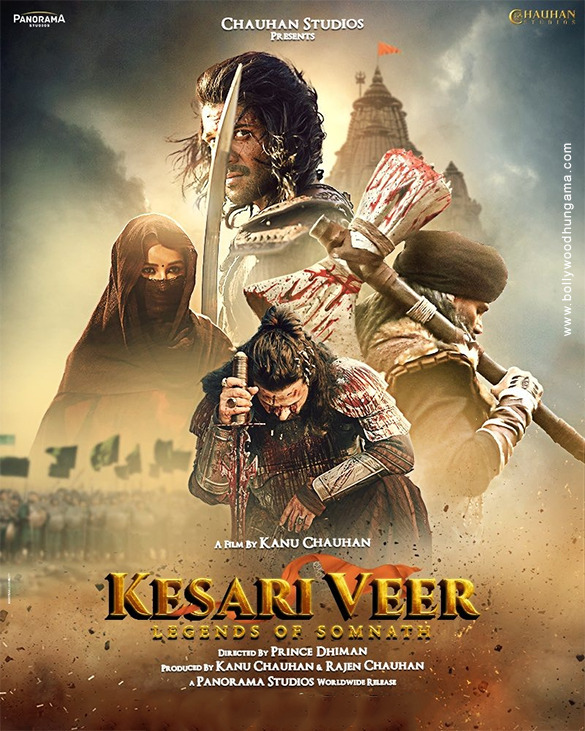KESARI VEER: A Cinematic Misfire That Struggles to Find Its Rhythm
As the credits roll for Kesari Veer, it’s hard not to feel a mix of disappointment and bewilderment. Primarily marketed as a high-octane historical drama, the film yields a lackluster performance reminiscent of mediocre musical numbers that start with high hopes but end up missing the beat. With a star-studded cast, including Suniel Shetty, Vivek Oberoi, Sooraj Pancholi, and Akanksha Sharma, one would have expected a compelling narrative accompanied by an engaging soundtrack. Instead, viewers are left with an amalgamation of tired tropes and underwhelming execution.
Understanding the Premise of KESARI VEER
Kesari Veer takes place in 14th century India, featuring the story of Hamirji Gohil (played by Sooraj Pancholi), a prince in self-exile fighting against oppression. Amidst his quest for justice, he falls in love with Rajal (Akanksha Sharma), whose father, Vegdaji (Suniel Shetty), does not approve of their love story. Enter Zafar Khan (Vivek Oberoi), a tyrant focused on pillaging the Somnath Temple. With the regional kings too intimidated to confront Zafar’s colossal army, it falls to Hamirji and Vegdaji to rally against the impending doom.
Story Arc vs. Execution: Where KESARI VEER Falters
While the foundation laid by Kanubhai Chauhan and Shitiz Srivastava had promise, the screenplay becomes a bottleneck. Their dialogue offers a few moments of levity, resulting in sporadic applause rather than a cohesive narrative. The storytelling falters from the outset, as random plot points abound, leaving the audience disoriented.
The direction lacks finesse, ultimately diluting the film’s potential impact. Instead of a seamless flow, transitions often feel abrupt and unnatural, reminiscent of a well-rehearsed track abruptly skipping, confusing both rhythm and mood.
A Comparative Breakdown of Key Elements
| Element | Kesari Veer | Similar Films |
|---|---|---|
| Direction | Weak and amateurish | Strong character-driven narratives |
| Visual Effects (VFX) | Underwhelming, outdated | Industry-standard, immersive experience |
| Climax Impact | Disjointed and hard to digest | Powerful resolutions and emotional depth |
| Audience Reception | Struggles to create buzz | Cult classics with enthusiastic fanfare |
The similarities with films like Baahubali and Chhaava are undeniable; several scenes evoke feelings of déjà vu that detract from Kesari Veer’s originality. The conclusion, initially gripping, crumbles in its final moments, further distancing itself from the engaging storytelling sought in historical dramas.
Minimal Musical Moments: An Underwhelming Score
Monty Sharma’s music contributes little to the film’s impact, failing to energize its core. Mass-oriented tracks fall flat and do not invoke the spirit of adventure often found in epic soundscapes. The background score struggles to accentuate tension effectively, coming across as awkward at crucial moments.
In contrast, audiences have come to expect vibrant harmonics in historical dramas. One can look to recent trends on platforms like Billboard for inspiration, where catchy, emotionally charged melodies enhance cinematic experiences. In Kesari Veer, those musical moments are few and far between.
Spotlight on Performances: The Silver Lining
Despite the film’s downfalls, certain performances shine. Sooraj Pancholi introduces a genuine sincerity to his character, particularly during action-driven scenes. Suniel Shetty, embodying Vegdaji, carries a robust presence that elevates the on-screen action. However, it’s Akanksha Sharma who surprises, delivering a memorable debut replete with charisma. Her dynamic screen presence steals the spotlight, making her one to watch in future endeavors.
Vivek Oberoi effectively encapsulates the antagonist role, drawing comparisons to other iconic historical villains—a testament to his ability to inhabit such characters convincingly.
Technical Aspects and Production Quality
When assessing technical execution, Kesari Veer’s production design resembles that of a 90s television drama, lacking the detail and care of cinematic standards. Vikash Joshi’s cinematography provides some aesthetic value, yet poor visual effects hamper the overall experience, reminiscent of outdated media renditions.
Costumes remain authentic to the era, expertly crafted by a talented team. However, the dismal editing drags out sequences that should have otherwise maintained momentum.
Final Thoughts: A Cautionary Tale for Historical Dramas
Ultimately, Kesari Veer arrives as a cautionary tale underscoring the importance of cohesive storytelling and innovative direction in historical dramas. It pales in comparison to established benchmarks like Chhaava and Baahubali, and it’s hard to foresee its success against competitive releases.
Audiences desiring rich narratives interwoven with strong musical foundations may find themselves exploring other options this season. As Kesari Veer attempts to navigate its way through the box office, it may become a lesson in how not to blend history and entertainment.
To discover more about cinematic gems and the musical narratives that elevate films, check out our detailed review of Agni here and brush up on Bollywood’s other hits here.
As we continue our journey through cinema, let’s hope upcoming films manage to strike the right note, infusing fresh life into the historical genre that Kesari Veer falters in achieving.

